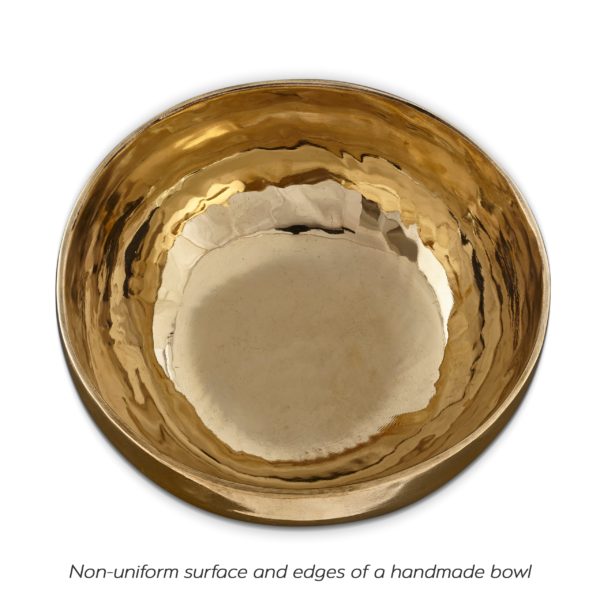If you’re new into sound healing or just curious about picking up your first singing bowl- you might be overwhelmed with the different options of singing bowls that are available.
They come in different shapes, sizes, colours and sounds and it can get confusing sometimes to know which one is best for you.
While numerous types exist, the primary classification hinges on whether the bowls are handmade (also known as hand-hammered or hand-beaten) or machine-made.
What differentiates Machine Made from handmade/hand-hammered/hand-beaten bowls?
Shape
Machine-made bowls exhibit a high degree of uniformity and symmetry on the surface. If you look at the picture below, you can observe that the edges of this machine made bowl are perfectly uniform, even and circular. This evenness is because these bowls are made using a machine.

In contrast, a close examination of the surface of a handmade bowl reveals irregularities and non-uniformity. This characteristic stems from the manual hammering and beating during the crafting process.

Frequency
Consequently, as a result of their structure, the frequency produced by both the singing bowls are also different.
Below is a screenshot of the frequency produced by a machine made bowl and if you observe, the frequency range is narrow. There is one fundamental frequency and the overtones because of the uniform and even shape of the bowl.

On the other hand, if you listen to the sound produced by the handmade bowl, the frequency range is broad and with more than one fundamental frequencies along with the overtones. The non-uniform shape is a contribution factor to a broader range of frequencies produced by the singing bowl. This broad range of frequencies produced by the bowl iis also why sound therapists prefer handmade bowls over machine made ones.

Material used for making
Generally, machine made bowls are made from brass which is an alloy of copper and zinc whereas handmade bowls are made of bronze or bell-metal which is an alloy of copper and tin. Usually few other additives are sometimes added to handmade singing bowls such as lead, mercury and very rarely gold and silver as well.
Cost
Due to the labor-intensive process of hand-hammering and hand-beating, handmade bowls require more time to manufacture, rendering them more expensive than their machine-made counterparts. Additionally, the construction material, bell-metal, is pricier than brass, contributing to the overall higher cost of handmade bowls.
Final Consideration:
If you’re getting into sound healing or interested in exploring the therapeutic effects of singing bowls, then it is highly recommended that you go for a handmade singing bowl. Whereas if you’re buying a singing bowl as a decorative piece or planning to use it sparingly or are tight on budget, then you could go for a machine made singing bowl.



